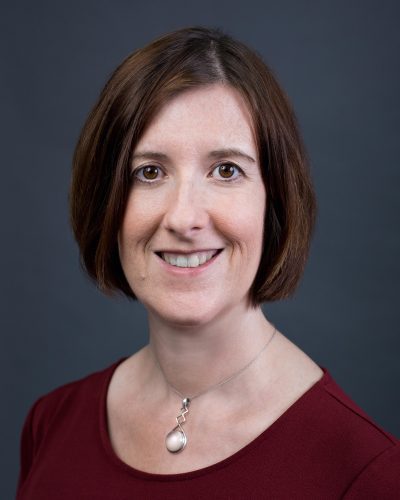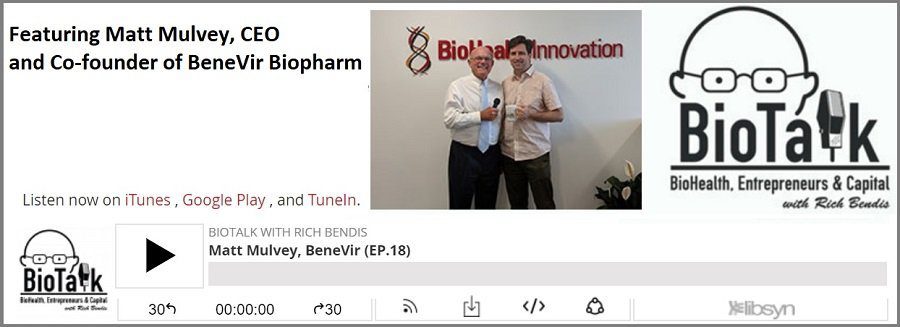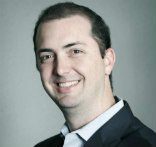
Q&A With BeneVir Co-Founder and COO, Katherine Sacksteder, PhD – The Path to a Landmark Acquisition (Part 1)
October 9, 2018
This has been a year marked by many notable biotech deals, especially in the immunotherapy market. One deal, in particular, has generated more local excitement in the BioHealth Capital Region than any other; that is the BeneVir acquisition by Janssen, a JNJ company. Likewise, of the many startup stories and local entrepreneurs we’ve highlighted this past year, none is as unique and interesting as that of BeneVir Co-Founder and COO, Katherine (Katie) Sacksteder, PhD.
From landing the perfect first job for a budding entrepreneur in training to launching with a startup with her husband, while raising two young kids, to a series of market events that seemed to pave the way for BeneVir’s big acquisition; Katie’s story is both impressive and inspirational.
I am excited and honored to share this interview so that others can hear the incredible journey that Katie has been on that led BeneVir to their blockbuster acquisition.
……
[BioBuzz] You’ve had some exciting news since we last saw each other early this Spring. For our readers who don’t know you yet, please tell us a little about you and your company. Oh, and the big news this past Spring.
[Katie] My name is Katie Sacksteder, and I’m the COO and a founder of BeneVir. We founded BeneVir in 2011 to develop a herpes-based oncolytic virus (OV) platform technology that we licensed out of NYU. In May of this year we signed a deal to be acquired by Janssen Biotech, Inc., one of the Janssen Pharmaceutical Companies of Johnson & Johnson, for a total deal value of potentially >$1B, provided all milestones are met.
What has this year been like for you, personally and professionally?
A lot has happened in the last year, and I remember very little of it! Just over a year ago I had my second son, and so we were dealing with a newborn and a toddler while working on the deal with Janssen and keeping the development plan on track. While we had experience with newborns, we didn’t have experience with selling a company. So it was quite a learning experience: we were trying to keep the product development moving along while simultaneously being responsive to Janssen’s science team, our lawyers, and our investors. I should have mentioned that I founded BeneVir with my husband, Matt Mulvey, who is the CEO of BeneVir, so our household was at a constant stress level of nuclear. But we survived.
We’re excited to announce the intended #acquisition of BeneVir Biopharm to advance and strengthen immuno-oncology #science for patients. Details here: https://t.co/tnCTbkbZSt pic.twitter.com/pVUBpR9etX
— Janssen Global (@JanssenGlobal) 2 май 2018 г.
Since your time at Johns Hopkins getting your Ph.D. you’ve now been in two biotech startups; did you always know that was the path you wanted to take?
Absolutely not. I knew pretty quickly in grad school that I didn’t want to be in the lab, but that’s all I had: a negative. I’m not sure how much this has changed, but when I was in school there was very little guidance or information readily available on career paths other than academia. I had heard of people going to work at companies or to be consultants, but I had no idea what that was like. I only knew that I wanted to get out of the lab right away, so academia wasn’t an attractive option to me. I actually applied to a wide variety of jobs: scientific sales/support at a microarray company, an editorial position at Nature Genetics, a website management position at Celera, and unadvertised positions at small biotech companies.
Your first job in industry was with Sequella. How did you get your start there and what were those first years like for you?
Sequella came out of my email attack on CEOs of small local biotech companies who had not posted any jobs available. I thought that since I was just out of grad school, it was going to be tough or impossible for me to get a job in industry that wasn’t in a lab. But I thought that small biotech start-ups might have some interest since they can have difficulty attracting more experienced people. I met with a few people, and Carol Nacy, the CEO of Sequella, took a chance on me. I started out as Director of Communications, where I wrote press releases, made an investor newsletter, and wrote grants. It was a fantastic learning experience: Carol is amazing, and having a female mentor was important to me.
Carol really let me do whatever work I wanted to get into within the company, and I was happy to go wherever she needed me since it meant I could see more aspects of the business. I think that the flexibility we both had worked well for both of us. In my time there I did communications, operations, finance, grant writing, grant management, manufacturing, and clinical trials. And probably other things that I don’t remember anymore. I don’t think I could have gained that breadth of experience at many other places, and it was crucial in transitioning to my own startup.
Tell me about your “Founding story” for BeneVir?
One of our founders, Ian Mohr, an NYU professor, was the inventor on a key patent for T-Vec, which eventually became the first oncolytic virus approved by the FDA. Matt (BeneVir’s CEO) was the first person in Ian’s lab and put a great deal of work into that technology before it was licensed out to create T-Vec. So, they knew what was good about the technology and how it could be improved. The technology that went into T-Vec created the first live virus treatment for cancer that could resist the anti-viral effects of innate immunity. But, the virus was still susceptible to premature clearance by adaptive immunity. So, they invented T-Stealth Technology, which allows any live virus treatment for cancer to hide from both innate and adaptive immunity – a completely immuno-stealth virus. Basically, BeneVir’s issued IP allows one to use a virus as a drug without having to worry about the immune system inactivating the drug before it’s done its job. Anyway, we decided in 2011 to found BeneVir and license Matt’s patents from NYU. We also secured some key angel support from a close friend. Matt worked on the company unpaid for a while, while I worked 3 jobs, and in 2012 we got two NIH SBIR awards to develop the technology. The work done with the NIH and angel support was very successful and led to a $12M Series A round in 2014, which took us through to the acquisition.
What is it about the technology and team that gave you the confidence to build a company around it?
Having the inventors of the technology as company founders, one of whom was the CEO, was really important, particularly because this is a preclinical product. I think once you get close to the clinic or are in the clinic, it becomes a little more cookie cutter and you don’t necessarily need the scientific inventors behind the company, but at earlier stages, it really helps. In addition, just before we founded BeneVir, the company developing T-Vec was acquired by Amgen for $425M upfront with a deal value >$1B. So that really validated the OV space and was critical to giving us the credibility that we needed to push the company forward.
Were there any aha moments these past 7 years where you really felt like you were on the path of something special?
I think that there have been a lot of those moments in the progression of the science, both from work internally and externally. Internally, one of them was when we validated the “T-Stealth” technology that forms the core of our IP, and were able to show that it provided an advantage over T-Vec. So that gave us data to support our claim that we were a second-generation improved version of an established, FDA-approved technology. Externally, the biggest “aha” moment was when we saw clinical data from Amgen that T-Vec could be combined with pembrolizumab and provide dramatic remissions in patients who had no expectation of responding to immunotherapy (or any other therapy).
It’s been said that it takes a village to grow a successful company. So, who are some of the people and organizations that have helped you all along this tough journey of starting and growing BeneVir?
We’ve had an enormous amount of help from lots of people and groups. When we founded the company, we got SBIR funding from the NCI, which was crucial in getting us to a point where we had data to sell to investors. We also got angel investment from a close friend, which was needed because you can’t pay IP costs from grant funding, and you don’t have a company without IP! In those the early days, we also got a lot of help from BioHealth Innovation (BHI), a group that supports the local biotech community. Rich Bendis, their President and CEO, has been a great resource for us when we need advice or to be introduced to the right person to solve a problem. BHI also paired us with Ram Aiyar, one of their Entrepreneurs in Residence. Ram had pharma and VC experience, and so he was able to bring that perspective to help us figure out what potential investors/partners were looking for. Another important person in our evolution was Andrew Koopman, who worked for the Office of Industrial Liaison at NYU, from which we licensed the technology. He was a great person to bounce ideas off of, and he introduced us to David Present and Cherine Plumaker of Pansend Life Sciences, who were our Series A investors. As our investors, David and Cherine were crucial in our success and in getting the deal with Janssen to be a great deal. There are many more, of course, but those are just a few examples.
How did the deal with Janssen come about and what has that experience been like?
Stay tuned for Part 2 of the interview with Dr. Katie Sacksteder for more on the Janssen acquisition and what’s next for BeneVir.
Author:
Chris Frew, @biotechmd
- About the Author
- Latest Posts
Over the past 11 years, Chris has grown BioBuzz into a respected brand that is recognized for its community building, networking events and news stories about the local biotech industry. In addition, he runs a Recruiting and Marketing Agency that helps companies attract top talent through a blended model that combines employer branding and marketing services together with a high powered recruiting solution.







